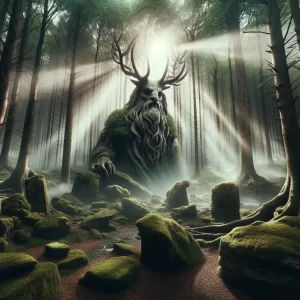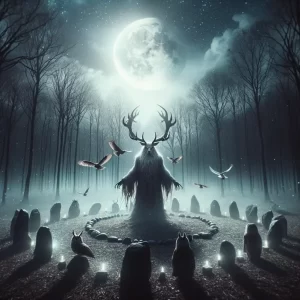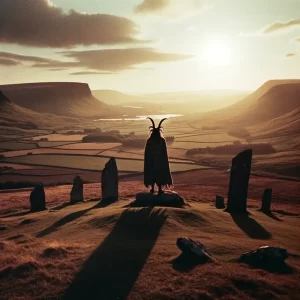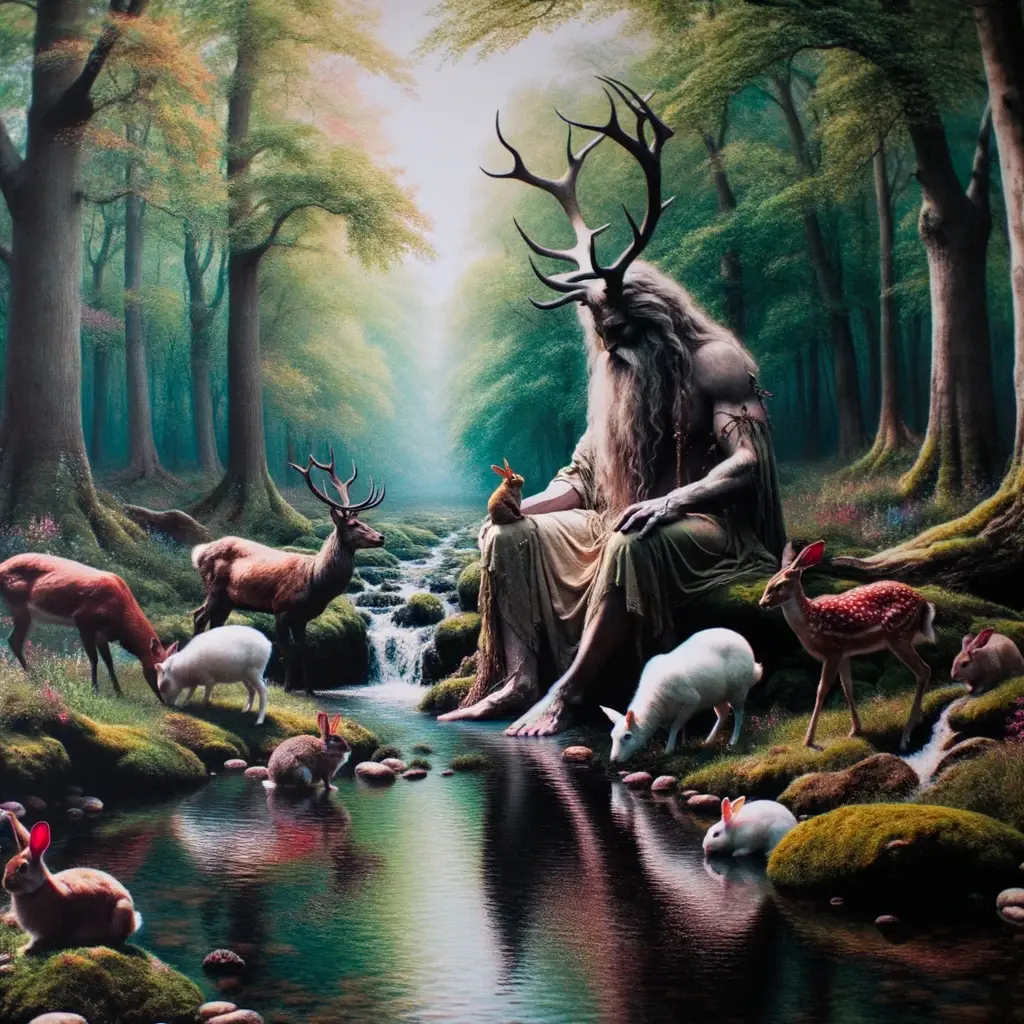Historical Background
Cernunnos, the horned god of the Celts, is a deity with a rich historical background. The earliest references to Cernunnos date back to the 1st century BCE, when he was worshipped by the Gauls. He was also known in other parts of Europe, including Denmark, France, Britain, and Ireland.
Cernunnos was a significant figure in Gaulish and Celtic religion, and his worship was widespread. He was associated with nature, fertility, and the wild, and was often depicted with antlers or horns on his head. In Celtic art, he is shown wearing a torc around his neck, a symbol of wealth and power.
The god was also associated with animals, particularly stags, horned serpents, dogs, and bulls. He was believed to have power over wild beasts, and was often depicted surrounded by animals in Celtic art.
Although there are few surviving artifacts and inscriptions related to Cernunnos, his presence in Celtic art and mythology is significant. He is often depicted in a seated, cross-legged position, with a bag of coins or a cornucopia, symbolizing wealth and abundance.
The worship of Cernunnos declined with the spread of Christianity, but his legacy lives on in modern neo-paganism and other spiritual practices. Today, he is revered as a symbol of nature, fertility, and the wild, and is celebrated in festivals and rituals throughout the world.

Depiction and Symbolism
Horned God
Cernunnos is most commonly depicted as a horned god, with antlers or stag horns. He is often shown seated cross-legged, with his antlers or horns extending above his head. The antlers are a symbol of his connection to the wild and his role as a protector of animals. The horns also represent strength and power, making him a formidable figure.
Lord of Wild Things
Cernunnos is known as the “Lord of Wild Things” due to his close association with animals and nature. He is often depicted surrounded by animals, such as stags, dogs, and bulls. This association with animals reflects his role as a protector of the wild and a symbol of the power of nature.
Lord of the Forest
Cernunnos is also known as the “Lord of the Forest,” due to his connection to the natural world. He is often depicted in a forest setting, surrounded by trees and wildlife. This association with the forest reflects his role as a guardian of nature and a symbol of the power of the natural world.
Green Man
Cernunnos is sometimes associated with the Green Man, a figure from English folklore who represents the spirit of nature. The Green Man is often depicted with leaves or foliage growing from his mouth, nose, or ears. This association with the Green Man reflects Cernunnos’ connection to the natural world and his role as a symbol of the power of nature.
Horned Serpent
In addition to his association with animals and nature, Cernunnos is also associated with the horned serpent. This symbolizes his connection to the underworld and his role as a guide to the afterlife. The horned serpent is also a symbol of transformation and rebirth, reflecting Cernunnos’ role as a symbol of the cycle of life and death.
Cernunnos and Celtic Mythology
Celtic God
Cernunnos is a god in Celtic mythology who is often depicted with antlers and associated with stags, horned serpents, dogs, and bulls. He is also known as Carnonos and is considered as the lord of wild things. The name Cernunnos is not frequently attested, but the similar images found throughout Europe suggest that this god was likely worshiped by many Celtic tribes in the Roman period.
Celtic Religion
Celtic religion was the polytheistic religion practiced by the Celts, a group of Indo-European peoples who lived in Europe during the Iron Age and Medieval Period. The religion was based on a pantheon of deities who were associated with different aspects of nature and life. The Celts believed that their gods and goddesses controlled the forces of nature, and they often offered sacrifices to them in order to gain their favor.
Celtic Deities
The Celtic pantheon was vast and complex, with many deities associated with different aspects of life. Some of the most important Celtic deities include:
- Dagda: the god of life and death, who was associated with fertility, agriculture, and magic.
- Morrigan: the goddess of war and fate, who was often depicted as a crow or raven.
- Lugh: the god of the sun and light, who was associated with skill and craftsmanship. The festival of Lughnasadh is named after him.
- Brigid: the goddess of poetry, healing, and smithcraft, who was often associated with fire and the hearth.
The Roman conquest of Celtic lands brought about a syncretism between Roman deities and Celtic deities. Cernunnos was sometimes identified with the Roman god Mercury, while Jupiter was associated with Taranis, the god of thunder.

Associations and Symbolic Meanings
Cernunnos was a powerful and archaic deity in Celtic religion. His attributes were generally consistent across different parts of the Celtic world. Cernunnos worship was wide and he was worshipped as the “lord of wild things.” The following sub-sections explore some of the associations and symbolic meanings of Cernunnos.
Nature and Animals
Cernunnos was associated with nature and wild animals. He was often depicted with antlers, which symbolized his connection to the forest and the hunt. He was also associated with stags, horned serpents, dogs, and bulls. Cernunnos was seen as the protector of forests and leader of the hunt, representing life and animals.
Fertility and Life
Cernunnos was also associated with fertility and life. He was seen as a symbol of the cycle of life, death, and rebirth. Cernunnos was often depicted holding or wearing a torc, a symbol of wealth and power. He was sometimes shown holding a bag of coins or grain and a cornucopia, representing abundance and prosperity.
Death and the Underworld
Cernunnos was also associated with death and the underworld. He was seen as a guide to the afterlife and a protector of the dead. Cernunnos was sometimes depicted as a horned serpent, symbolizing his connection to the underworld and the cycle of life and death.
Power and Strength
Cernunnos was a symbol of power and strength. He was often depicted with horns, which represented his strength and authority. Cernunnos was also associated with the oak tree, which was seen as a symbol of strength and endurance. He was sometimes depicted holding a silver or gold fruit, which represented his power and wealth.
Cernunnos in Art and Artifacts
Cernunnos, the horned god, is one of the most recognizable figures in Celtic art. He is often depicted with antlers, a beard, and a torc around his neck. He is associated with nature, fertility, and the underworld. Cernunnos appears in various forms of art, including the Gundestrup Cauldron, rock art, and sitting cross-legged figures.
Gundestrup Cauldron
The Gundestrup Cauldron is a silver vessel that dates back to the 1st century BCE. It was discovered in a peat bog in Denmark in 1891. The cauldron is decorated with intricate scenes that depict various Celtic deities, including Cernunnos. In one panel, Cernunnos is shown sitting cross-legged and holding a torc. He is surrounded by animals, including stags, bulls, and snakes. The panel is thought to represent the god’s role as a protector of animals.
Rock Art
Rock art is another form of art that often depicts Cernunnos. One of the most famous examples of Cernunnos in rock art is the Val Camonica in Italy. The site contains over 140,000 rock carvings that date back to the Iron Age. Many of the carvings depict Cernunnos with his antlers and torc. He is often shown alongside other deities, including Epona, the goddess of horses.
Sitting Cross-Legged
Sitting cross-legged figures are another common representation of Cernunnos. These figures are often made of stone and date back to the Iron Age. One example of a sitting cross-legged figure is the Jutland Figure. The figure is made of sandstone and depicts a horned deity sitting cross-legged. The figure is thought to represent Cernunnos and is one of the few examples of a sitting cross-legged figure found in Northern Europe.
Cernunnos and Other Deities
Cernunnos is a complex deity that has been associated with various other gods and goddesses throughout history. Here are some of the deities that have been linked to Cernunnos:
Herne the Hunter
Herne the Hunter is a figure from English folklore who is often associated with Cernunnos. Herne is depicted as a ghostly figure who haunts Windsor Forest. He is said to be a guardian of the forest and a protector of wildlife. Like Cernunnos, Herne is often depicted with antlers.
Pan
Pan is a Greek god of nature and the wild. He is often associated with Cernunnos because of their similar roles as protectors of wildlife. Pan is depicted as a half-man, half-goat creature with horns and a tail. He is also associated with music and fertility.
Epona
Epona is a Celtic goddess who is often associated with horses. She is sometimes depicted riding a horse and is considered a protector of horses and horsemen. Epona is also associated with fertility and is sometimes depicted holding a cornucopia.
Sirona
Sirona is a Celtic goddess of healing and fertility. She is often associated with Cernunnos because of their shared association with fertility. Sirona is depicted holding a snake and a bowl of eggs, which are symbols of fertility.
Dis Pater
Dis Pater is a Roman god of the underworld. He is sometimes associated with Cernunnos because of their shared association with death and the underworld. Dis Pater is often depicted holding a scepter and wearing a helmet.
Overall, Cernunnos is a complex deity who has been associated with many other gods and goddesses throughout history. While these associations are not always clear-cut, they provide insight into the various roles and attributes that Cernunnos has been associated with over time.

Cernunnos and Modern Interpretations
God of the Witches
Cernunnos, the Celtic god of fertility and the wild, has been associated with various interpretations in modern times. One of the most popular interpretations is that of Cernunnos being the god of the witches. This interpretation is based on the theories of Margaret Murray, a British anthropologist who claimed that Cernunnos was the god worshipped by witches during the medieval period.
However, Murray’s theories have been widely discredited by modern scholars, who argue that her claims were based on flawed research and biased interpretations. Despite this, the association between Cernunnos and witchcraft continues to be popular among modern practitioners of neopaganism.
Demon
In Christian mythology, Cernunnos has been associated with the devil and demonology. This association is largely due to the Christian Church’s efforts to demonize pagan gods and goddesses during the Middle Ages.
However, there is no evidence to suggest that Cernunnos was ever worshipped as a demon by the Celts or Gallo-Romans. In fact, Cernunnos was widely revered as a benevolent deity who protected the natural world and its creatures.
Protector
Another modern interpretation of Cernunnos is that of a protector. This interpretation is based on the god’s association with the wild and his role as a fertility deity.
Cernunnos was believed to be a guardian of the natural world, and was often depicted with animals such as stags, dogs, and horned serpents. He was also associated with the seasons and the cycle of life and death, and was believed to ensure the fertility of crops and livestock.
Mother
In some modern interpretations, Cernunnos has been associated with the concept of the divine feminine. This association is based on the god’s role as a fertility deity and his association with the natural world.
Some neopagan practitioners believe that Cernunnos represents a balance between masculine and feminine energies, and that he embodies the nurturing and protective qualities traditionally associated with the mother goddess.
Despite the many interpretations of Cernunnos in modern times, it is important to remember that our understanding of this ancient deity is limited by the fragmentary nature of the surviving evidence. While Cernunnos continues to capture the imagination of modern practitioners of neopaganism, we must remain cautious in our interpretations and avoid making exaggerated or false claims about this enigmatic god.
Cernunnos in Different Regions
Paris
Cernunnos is a popular figure in early Celtic religion, and his name comes from a single Roman-era inscription found beneath Notre Dame Cathedral in Paris. The inscription, which dates back to the first century AD, refers to a god with antlers, seated cross-legged, and associated with stags, horned serpents, dogs, and bulls. Paris is therefore an important location for studying the history and mythology of Cernunnos.
Germanic Regions
Cernunnos was widely worshipped as the “lord of wild things” in Celtic religion, and his attributes were generally consistent across different parts of the Celtic world. However, some Germanic regions also had their own versions of Cernunnos, such as Herne the Hunter in English folklore and the Wild Hunt in Germanic mythology. These versions of Cernunnos were often associated with hunting, the wilderness, and the supernatural.
Luxembourg
Luxembourg is a country with a rich history of Celtic and Germanic cultures, and it is therefore a significant location for understanding the mythology of Cernunnos. In Luxembourg, Cernunnos is often depicted as a horned god with a torc and a bag of coins, similar to his depictions in ancient Celtic and Gallo-Roman religion. He is also associated with nature, fertility, and the cycle of life and death.
Cernunnos and Ritual Practices
Cernunnos, the Celtic god of the forest, was widely worshipped in ancient Celtic religion. He was associated with various symbols, including stags, horned serpents, dogs, and bulls. Cernunnos was also depicted holding or wearing a torc, a type of necklace, and sometimes holding a bag of coins or grain and a cornucopia.
Ritual practices associated with Cernunnos often involved offerings of leaves, as he was considered the lord of wild things. These leaves were often oak or ivy leaves, which were significant in Celtic mythology. The oak tree was seen as a symbol of strength and endurance, while ivy represented the connection between the physical and spiritual worlds.
Another important aspect of Cernunnos worship was the use of torcs. These necklaces were often made of gold or other precious metals and were worn as a symbol of status and wealth. They were also used in ritual practices as offerings to the god.
Cernunnos was believed to be a powerful deity who could bring life to the forest and the creatures that lived within it. As such, offerings of grain or other crops were also common during ritual practices. These offerings were seen as a way to honor the god and ensure a bountiful harvest.
Cernunnos, Name and Etymology
Cernunnos is a deity from Celtic mythology, known for his association with fertility, animals, wealth, and the underworld. The name Cernunnos is derived from the Gaulish word “karnon,” which means “horn” or “antler.” The word “karnon” is cognate with Latin “cornu” and Germanic “*hurnaz,” ultimately from Proto-Indo-European “*k̑r̥no-.” The etymon “karn-” appears in both Gaulish and Galatian branches of Continental Celtic.
The name Cernunnos is often translated as “horned one,” referring to the antlers he is often depicted wearing. He is also sometimes referred to as the “Lord of the Wild Things,” reflecting his association with the natural world.
Cernunnos is one of the most iconic gods of the Celtic pantheon, but little is known about him beyond his name and his association with certain themes. However, some scholars have suggested that he may have been associated with shamanism and the spirit world, based on his association with the underworld and his antlers, which could symbolize a connection to the spirit realm.

Frequently Asked Questions
What is the meaning of Cernunnos in Celtic mythology?
Cernunnos is a powerful deity in Celtic mythology, often depicted as the “lord of wild things.” He is associated with nature, fertility, and the cycle of life, death, and rebirth. He is also known as the “Horned One,” and is often depicted with antlers or horns.
What symbols are associated with Cernunnos?
Cernunnos is often associated with the stag, as well as other animals such as the boar and the serpent. Other symbols associated with Cernunnos include the torc (a type of neck-ring), the horned serpent, and the ram-headed serpent.
What is the significance of Cernunnos statues?
Cernunnos statues are often used as symbols of fertility, abundance, and prosperity. They are also used in modern pagan traditions as representations of the Horned God.
How was Cernunnos worshipped in ancient times?
The exact details of how Cernunnos was worshipped in ancient times are not well-known, as much of the original mythos surrounding him has been lost. However, it is believed that he was worshipped as a mediator between man and nature, and that he was associated with the cycle of life, death, and rebirth.
What is the role of Cernunnos in modern pagan traditions?
Cernunnos is often worshipped in modern pagan traditions as a representation of the Horned God. He is associated with nature, fertility, and the cycle of life, death, and rebirth. He is also often seen as a protector of the natural world.
What is the relationship between Cernunnos and the goddess in Celtic mythology?
The exact relationship between Cernunnos and the goddess in Celtic mythology is not well-known. However, it is believed that he was often associated with the goddess as a representation of the male aspect of nature, while the goddess represented the female aspect. Together, they were seen as representing the balance and harmony of the natural world.
Want to learn more about Cernunnos? Check out this video below:

